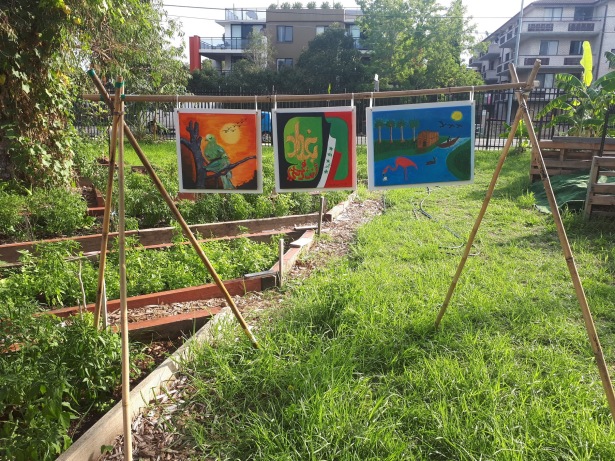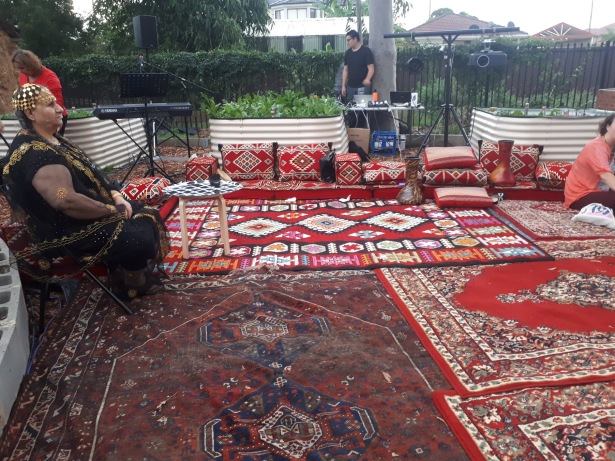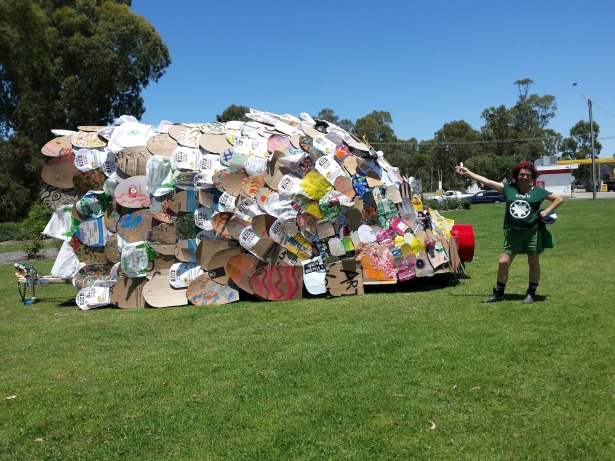Imogen Ross has developed a variety of creative responses to live performance, production and event needs for over 33 years. She collaborates with an array of artists and organisations, teasing out the creative pulse within each project and making it manifest. Imogen is the co-author of ‘Performance Design in Australia’ (2001) and runs the APDGreen Conversations for the Australian Production Design Guild.
How did your interest in Ecoscenography and sustainable theatre production begin?
I think my interest in sustainable theatre production has been there from the very start. As a young designer, I was always concerned about where the set would go at the end of the show. Living in a rural area meant that we all knew exactly what ‘landfill’ meant: the whole set was either going to be driven to the local tip on a Sunday morning OR it was going to be stored in someone’s shed until it could be re-used. The emphasis was always on re-use and upcycling because it felt like we were pouring our hard-earned money into the dirt when we took things to the tip. Working in a small theatre company means that everyone is involved in every step of the way, and every wasteful decision is discussed as the ramifications have impact on future budgets.
Some designers walk away at opening night and never look back. I seldom assume it is someone else’s responsibility to solve the waste problems created by my sets and I always try to present upcycling or recycling pathways for my design choices. I am well known for recycling and upcycling my sets/costumes. Many individuals and theatre companies now contact me to see if I know where to re-home post-show items.

What does Ecoscenography mean to you? How do you define it (for yourself and others)?
Ecoscenography is about being environmentally consciousness at every step of the design and story-telling process. It is a conscious decision to choose upcycled elements, to re-use existing elements and to recycle them. I like to know the carbon impact of my design decisions, to discuss alternatives and be constantly learning.
Ecoscenography is also about discussing the ‘end of life’ stage of the project with the Director, the Production Manager, the actors and the crew. It is about having regular discussions; including the unlearning of problematic methods, techniques and technologies in performance design. It is about creating story driven, not ego/status- driven decisions.

Can you tell me about one of your most interesting Ecoscenography projects?
Many of my shows designed for Monkey Baa Theatre have engaged with the serendipity of using repurposed and found items and second hand fabrics. The rigours of year-long touring has taught me the lesson that 2nd hand and true vintage costumes are NOT such a good idea but I will always try to include upcycled elements like 2nd hand buttons and fabrics into the making of hero costumes and their doubles.
In Diary of a Wombat, we collaborated with master puppet maker Briony Anderson who always incorporates upcycled elements into her work. The inner structures of her magnificent wombat are covered in ‘Who Gives a Crap’ toilet paper covers – a marvelous repurposing of something already recycled in its construction. For this show I designed and made an eight metre long ‘Earth Quilt’ made almost entirely of second hand fabrics to represent the cross-section of the landscape as it descends to a wombat burrow. It was stitched over two intense weeks in one long uncut piece with master sewer Matt Aberline in his tiny studio in Enmore. The scraps from the fabrics were used as stuffing so there was little wastage.

For me, upcycling and the use of ‘found’ items is not about stretching the budget (though it certainly was an initial factor when I was younger, working on unfunded Co-op shows) but about allowing the element of chance and happenstance to enter my design process. I enjoy accepting the design challenge of using what is thrown before me. I enjoy looking sideways at people’s rubbish piles, wondering if the missing piece to the puzzle may be there. So many design problems have been solved by the weird and wonderful things I find in my regular travels to and from a theatre space. The layers of complex spatial/colour/texture thinking we designers do as we process a play in our minds may actually bring certain objects to the fore – things we have not noticed lying about before on the periphery.
Second hand objects carry a resonance of their previous experiences. They bring something unique to the visual story-telling, even if no one but the performer or myself know its history. When designing costumes at Shakespeare’s Globe in 2003, someone in Australia asked me how on earth it could be justified spending all that money on hand-making items using 16th century style fabrics when it would be just as easy to use a sewing machine with store-bought fabrics. My answer was that it is the difference between tasting Cadbury’s dairy milk chocolate in a packet and tasting a Belgian handmade chocolate. They are both chocolate right? No. The sensory experience is completely different, though they both look like chocolate. The resonance of the chocolate maker’s hands is in one, the action of a machine in the other.
Can you tell me more about your community-engaged projects?
In 2018 I was asked by Karen Therese the artistic director of Powerhouse Youth Theatre (PYT) to work with them on a community theatre event called Little Baghdad: Cafes and Gardens in Fairfield. It was to be the culmination of two years of working closely with a mostly refugee Iraqi community in the grounds of Fairfield High School, with the assistance of the Parent’s Cafe: a locally run organisation that builds community, provideing education and employment for newly-arrived adults from war-torn countries.
My design brief was to bring together all the different elements that the community had been working on to tell their stories and weave a space for the audience to engage directly with the performers, culminating in a feast, with music, poetry and Arabic folk dancing. I worked with the Iraqi community for 6 weeks, helping to build and design a community garden with them, learning new gardening methods and exploring many new tastes. I found that sitting and listening was as much a part of the design process, as it was driving home while listening to Iraqi music and thinking about how many milkcrates I could safely fit into a 5m x 8m space.

PYT recognises that sharing food and music are just as important as listening to performers tell a story. Musicians led the audience through the gardens as the sun set, introducing spectators to Iraqi language and culture while inviting them to taste the freshly cooked produce. Later, using the raised garden beds as room dividers, we laid out dozens of carpets and cushions made from upcycled hessian bags and Iraqi bedspreads. I covered milk crates with secondhand fabrics and foam and made instant tables from stackable timber stools. We used solar powered lighting for all but the stage area, with candles on every table. The lit trees became our backdrop.
At the end of the 2nd week of nightly performances, we donated as much as we could back to the community. The rugs and cushions were donated to the Parent’s Cafe; the milk crate cushions were donated to a struggling social-enterprise night market in Wollongong that could not afford seating; and the solar powered lighting was shared with a sustainable funeral event company that holds regular community events. PYT does not have much storage space in its tiny offices in Fairfield, so they always plan the waste streams of their sets and costumes carefully in pre-production.

What tips would you give to a scenographer who is exploring sustainable practice for the first time?
- Don’t start with the idea that everything must be recyclable. Many things that are not recyclable can still be re-homed, re-used and reimagined by others.
- Sustainability is about being creative and having a willingness to discuss alternative solutions with directors and production managers. Don’t be afraid of asking, ‘how do we solve this together’?
- Always mention cost saving strategies when talking to the production manager. If something is more expensive to buy initially but will save the production money in the long term, promote this!
- Ask for things to be put in writing. It is amazing how a sustainability discussion at the beginning of a process can be easily forgotten or overridden at the end of the process due to stress and time restraints.

What do you think the future of theatre will look like for a climate-resilient world?
I think we will become less ego driven in our designs. I was appalled at a recent panel discussion of graduates from a leading theatre design school when asked about their thoughts on re-use and re-cycling. This new generation of designers was still espousing very outmoded ideas about the need for a designer to assert their style on a production by never using elements from someone else’s design. It was as if the word re-use was a dirty word.
In the future, I think the designers who are clever and creative in their constant re-use and re-imaging of scenic elements between productions will be lauded. This is not about appearing old fashioned and retrospective, as some designers have expressed their fear to me. Instead, new material technologies may make this re-imagining of scenic elements even more exciting, as we can reduce things back to their base elements before re-constructing a new purpose.

What are you working on now?
During the bushfires and COVID restrictions of 2020 I adapted and readapted an ongoing collaborative design project called The Chaos Loom – Habitats for an Uncertain Future.
This year I want to work more closely with nature and develop a stronger ecoscenographic voice. I am not sure yet where this decision will take my practice.
Until then, I am working on Life:
Finding joy.
Relationships in all their messy clunky forms.
Solo/group exhibitions with a range of local artists
Teaching the art of ‘seeing, listening and observing’ to young artists
Studying for a masters/phd in the future (soon)
Writing more. Learning more.
Growing things in my guerilla garden and creating spontaneous community sculptures to surprise passersby.
Watch this space…

(Top photo: Snugglepot (Jacob Warner) and Cuddlepie (Kirk Page) asleep on the 360 degree rotating tree trunk. Snugglepot and Cuddlepie (CDP, 2015). Director: Susanna Dowling.Set Designer: Imogen Ross. Costume Designer: Matthew Aberline. Photo Credit: Branco Gaica.)
The post, Resourceful ingenuity: Interview with performance designer Imogen Ross (Australia), appeared first on Ecoscenography.
———-
Ecoscenography.com has been instigated by designer Tanja Beer – a PhD candidate at the University of Melbourne, Australia, investigating the application of ecological design principles to theatre.
Tanja Beer is a researcher and practitioner in ecological design for performance and the creator of The Living Stage – an ecoscenographic work that combines stage design, permaculture and community engagement to create recyclable, biodegradable and edible performance spaces. Tanja has more than 15 years professional experience, including creating over 50 designs for a variety of theatre companies and festivals in Australia (Sydney Opera House, Melbourne International Arts Festival, Queensland Theatre Company, Melbourne Theatre Company, Arts Centre) and overseas (including projects in Vienna, London, Cardiff and Tokyo).
Since 2011, Tanja has been investigating sustainable practices in the theatre. International projects have included a 2011 Asialink Residency (Australia Council for the Arts) with the Tokyo Institute of Technology and a residency with the Royal Central School of Speech and Drama (London) funded by a Norman Macgeorge Scholarship from the University of Melbourne. In 2013, Tanja worked as “activist-in-residence†at Julie’s Bicycle (London), and featured her work at the 2013 World Stage Design Congress (Cardiff)
Tanja has a Masters in Stage Design (KUG, Austria), a Graduate Diploma in Performance Making (VCA, Australia) and is currently a PhD candidate at the University of Melbourne where she also teaches subjects in Design Research, Scenography and Climate Change. A passionate teacher and facilitator, Tanja has been invited as a guest lecturer and speaker at performing arts schools and events in Australia, Canada, the USA and UK. Her design work has been featured in The Age and The Guardian and can be viewed at www.tanjabeer.com
Powered by WPeMatico


